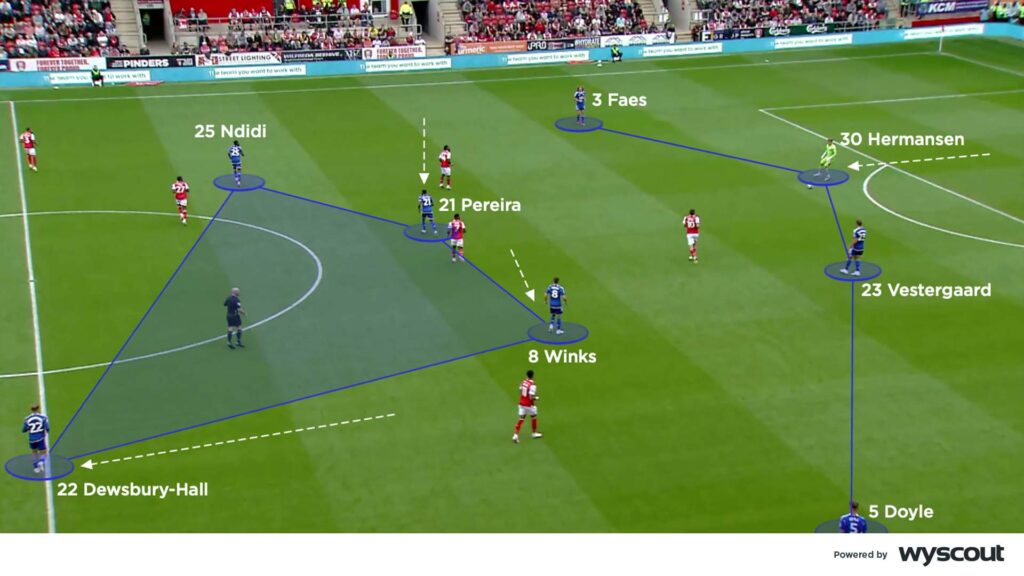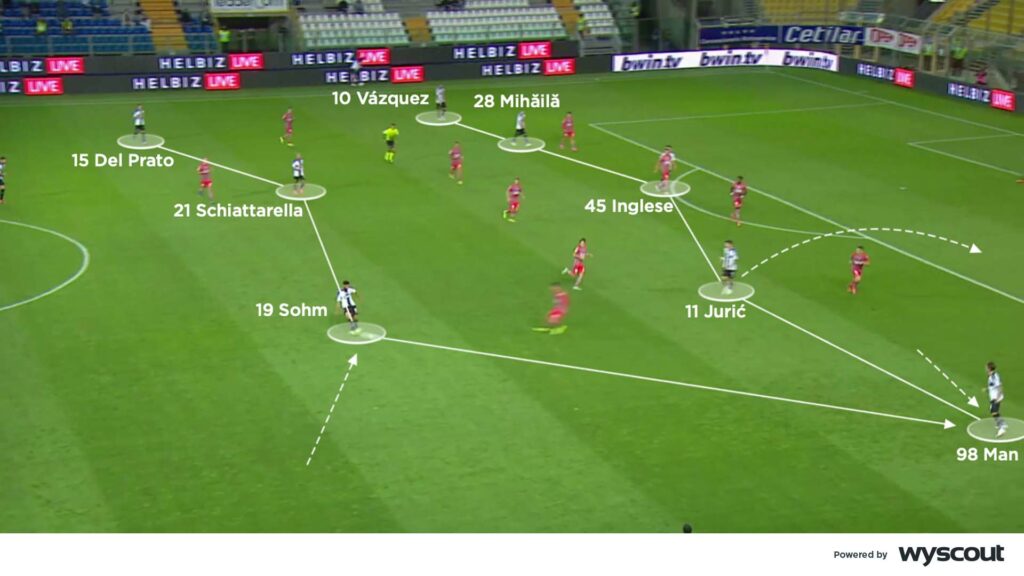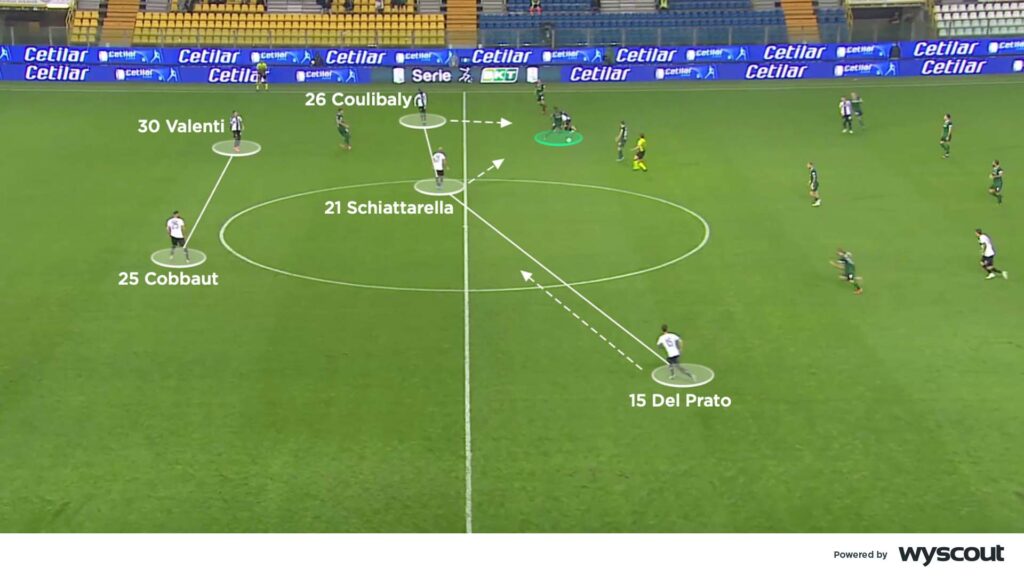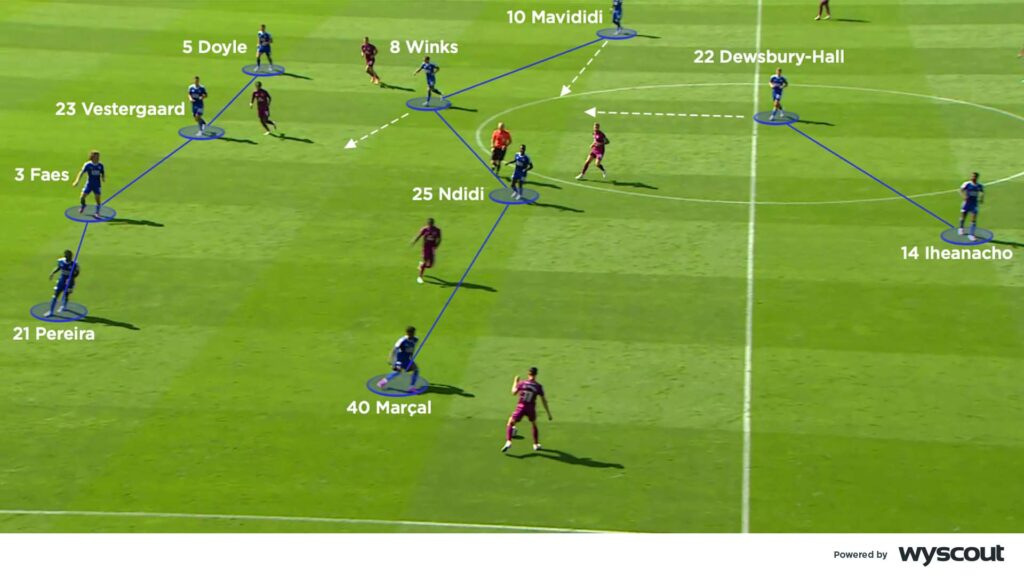Making moves has been fundamental to Enzo Maresca’s football coaching career. When studying at the legendary Italian coaching centre, Coverciano, his thesis was titled Football and Chess. “There are a lot of similarities,” Maresca said, comparing the two games. “The most important is positional play and strategy. For a coach, it’s important to have the mentality of a chess player: develop a plan, study counter moves, choose the arrangement of the pieces.”
His favoured tactical moves on the pitch have no doubt been shaped by the moves he has made from club to club, and country to country. The Italian started his playing career in AC Milan’s youth team, in the number six and eight roles. There, he developed a friendship with the team’s number 10 – a certain Roberto De Zerbi.
Maresca made a bold switch to West Bromwich Albion as an 18-year-old, getting his first taste of senior football in England’s second tier. Moves to Juventus – where he played for Carlo Ancelotti and Marcello Lippi – and Sevilla yielded one Serie A title, two UEFA Cups and a Copa del Rey. A season with Olympiacos added to his experience of different football cultures.
An 18-month spell playing under Manuel Pellegrini at Malaga followed, during which the Chilean told Maresca he had the potential to become a good coach. After initial coaching spells in Serie B with Ascoli and then at Sevilla, he then joined Pellegrini’s coaching staff at West Ham in the summer of 2018.
By this point, Maresca had developed a reputation as a progressive coach with excellent attention to positional play. It perhaps came as no surprise when, in 2020, Pep Guardiola recruited him to take charge of Manchester City’s elite development squad (EDS). Maresca duly won City their maiden Premier League 2 title, with a team including Roméo Lavia, Cole Palmer and Tommy Doyle.
A first head-coach role followed in 2021, at Serie B Parma, but ended after just 14 matches. Guardiola didn’t hesitate to bring Maresca back as first-team assistant for the treble-winning campaign, before Leicester offered him the job as their head coach.
Below, our UEFA-licensed coaches have analysed Enzo Maresca’s tactics and his coaching principles, in and out of possession.
Deeper build-up

Maresca places a high value on a deep build-up, with short passes from the back line to beat a high press. The goalkeeper plays a big role in this strategy, often joining the back line (below). This helps create an overload when needed, usually if an opponent applies a player-oriented press.
Maresca has often opted for a back four in a 4-2-3-1 or 4-3-3 formation. The goalkeeper joining the play allows the Italian to push one of his full-backs inside and keep four in the back line. In his 4-3-3 shape at Leicester, an inverting full-back helps form a double pivot (above), positioned to receive from the defenders. The goalkeeper’s involvement and the inverted full-back are ploys familiar from his Manchester City EDS sides.
Leicester have a free man within their deeper build-up should the opposition jump the goalkeeper to press – unless one of the opposing back line moves very high, in which case Leicester’s front three are then player-for-player. With first-time passing and clever angles of support from the double pivot, Leicester can find a free player to turn unopposed and progress up the pitch.
Maresca’s Parma team also attempted to build from the back, even though they averaged less possession than Leicester have during his early tenure at the King Power Stadium. The Serie B side had a full-back move narrow on the side opposite the ball, after they had built around the opposing press. The other full-back would simultaneously advance high to join the attack, or support underneath the number eight and winger. At Leicester, by contrast, the full-back looks to invert before the ball is played beyond the opponent’s first line.
Number-eight threats

At Leicester, an inverted full-back forming a double pivot allows the number eights to start higher. Here, they can then attack the inside channels inside the wide attackers, which also gives extra support around the single central forward. In Leicester’s early games under Maresca, attacking the inside channels has proven effective. These are patterns also seen from his Parma and Manchester City EDS teams.
When Parma’s full-backs narrowed in building an attack, the number eights would push forward into the front line in what in effect became a 2-3-5 (below). At Leicester, with a full-back forward much earlier than at Parma, the attacking shape looks more like a 3-2-4-1.
Both systems require aggressive runs in behind from the number eights. Whenever the opposing full-back jumps out to press the wide attackers, number-eight runs are available (below). This is especially the case if the centre-forward pins the next closest defender.
In only one of Maresca’s first seven games at Leicester did his team have less than 63 per cent possession. This often locks the opposition into mid and low-blocks for long periods. Inside-channel runs from the eights can penetrate the back line, taking the pressure off the centre-forward to make runs beyond.
If opposing midfielders track these runs and nullify the eights, the central-midfield unit with the inverted full-back(s) can dominate the ball. This works to guarantee high ball possession. Maresca’s wingers can then attack inwards, once the eights have cleared out, adding to the central overload and offering a goal threat.
Defending the counter-attack

At Leicester, as with Parma, the front line is a five in the attacking phase. Maresca’s set-up in attack in Serie B differed in the shape of players underneath the ball, compared with his early days as a manager in the Championship.
Due to Leicester’s rotations, in the attacking phase they often have three players in the back line, with a double pivot screening. This forms a 3-2 shape underneath the ball. Most of the protection, to guard against potential counter-attacks, sets up in central spaces.
This back three has centre-backs ready to step up and deal with wide counter-attacks. With the double pivot protecting ahead of a middle centre-back, the wide centre-backs must delay counter-attacks while their higher attacking teammates recover.
At Parma, the cover at defensive transition featured two in the back line and three ahead, in a 2-3 shape. The second line was usually made up of both full-backs and the single pivot from the 4-3-3. Maresca’s Parma team therefore had more instant, aggressive pressing and duelling underneath the ball, compared with Leicester’s double pivot. The extra player closer to the ball reduced the need for back-pressing, especially from the eights.
This obviously came with some defensive risk if the second line didn’t win the ball, or delay long enough to allow forward teammates to recover their defensive shape. In that case, a back line of two found it very difficult to cover wide spaces (below).
Locking the ball on one side
Maresca wants his sides to press and quickly regain the ball, with the aim of dominating possession and limiting opposition attacks. Leicester have typically converted into a 4-4-2 to press, as his Manchester City EDS team did. This requires one of the eights to jump forward alongside the central striker, as the latter attempts to force the ball one way.
Should they lock the ball on one side, the jumping number eight is ready to press any attempt to switch back across. The opposite winger also narrows, allowing the two central midfielders to move over, with the closest winger pushing high to press. The opposite full-back should also support, with Leicester locking the ball on one side in an attempt to regain possession.

When high pressing isn’t an option, Leicester have dropped into a block that maintains a 4-4-2 shape. One of the number eights remains in the first line, with the two other central midfielders staggered slightly (below). One drops back to cover the space between the lines, supporting the central defenders. Their gap in midfield is then filled by the high number eight back-pressing, or a winger moving inside, leaving a wide area free. If the opposition switches play from one touchline to the other, Leicester slide across, with the same defensive movements in midfield happening on the far side.
At Parma, Maresca encouraged his side to lock and force play one way, albeit from a 4-3-3 shape. The entire front line jumped on to the opposing back line, with the central midfield holding their shape to screen any central passes. The full-backs aggressively supported in the wide areas much earlier than his Manchester City and Leicester teams. As a result, there was a big emphasis on regaining possession in wide areas through high-intensity running from wide players.
If teams played over the wingers, the 4-3-3 quickly became a 4-1-4-1 block, with the central midfielders focused on protecting the middle. Parma’s full-backs would still jump out to press, with wingers required to recover back and double up in support. The high-energy press in wide areas also occurred when Parma dropped into a set block.
Maresca wasn’t given long to implement his ideas in that first senior head-coach role. Four wins and five draws from 14 games in charge of Parma saw him shown the door at the Stadio Ennio Tardini. At Leicester, he chalked up four victories in his first four Championship games in charge. The aim now is to make his next major move into the Premier League.
Leave a Reply